Even in the harsh conditions of the Siberian and Altai Territory, amateur winegrowers grow juicy and sweet grapes. One of frost-resistant crops is the variety “In memory of Dombkowska”. In the conditions of a short northern summer, he manages to grow and give a good harvest.
Content
Grade Features
“In memory of Dombkovskaya” was bred in 1993 by the famous breeder Fedor Shatilov. Originally had a technical name - ChBZ (black seedless winter hardy). But then it got a modern name.
The hybrid comes from breeding varieties - "Dawn of the North" and "Kishmish unique." From them, grapes inherited resistance to frost and the special taste of seedless berries. A special feature of the variety is rapid growth.
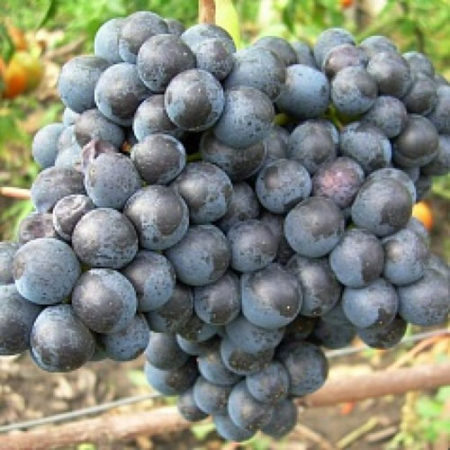 In a short summer, a large bush has time to grow, a tasty juicy berry ripens. Like “Kishmish unique,” there are no seeds in the fruits. Grapes are classified as early ripe varieties. The clusters ripen in a short 90 days from the day of vegetation. By mid-August - early September, you can already harvest. In particularly hot summers, berry ripening occurs earlier.
In a short summer, a large bush has time to grow, a tasty juicy berry ripens. Like “Kishmish unique,” there are no seeds in the fruits. Grapes are classified as early ripe varieties. The clusters ripen in a short 90 days from the day of vegetation. By mid-August - early September, you can already harvest. In particularly hot summers, berry ripening occurs earlier.
They do not have to be taken off the branches immediately after ripening. Many winegrowers leave clusters on the bushes until the end of autumn, so that the berries are properly nourished by the sun. A mature crop takes on great sweetness.
With proper planting, seedlings grow and develop rapidly. Already in the second year of life, the plant begins to bear fruit. In the fifth year, it is possible to obtain solid yields. With one bush, with good care, it is possible to collect on average up to 150 kg of berries.
The variety is frost-resistant. With poor shelter withstands frosts to minus 28 degrees. In colder winters, more thorough shelter is required. The bushes grow well, despite the adverse weather conditions. Grapes bear fruit well in the northern latitudes on the lands of complicated farming.
“In memory of Dombkovskaya” is classified as table-and-raisin variety. But winegrowers claim that grapes have a universal purpose. Fruits are pleasant to eat fresh. Of these, jam, compotes are boiled; served with meat dishes. Use for drying on raisins. From ripe berries, a good homemade wine is obtained.
Culture Description
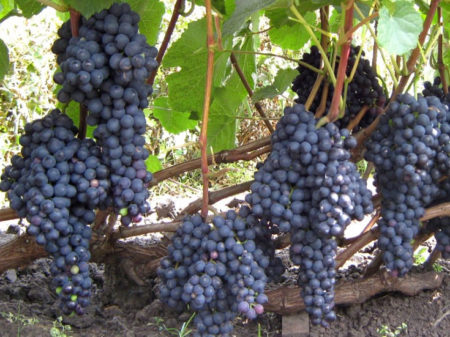 The grape bushes are developed and powerful in structure. During the warm period, the vine has time to grow to five meters. The bark is light brown, smooth. The leaves are green, carved, three-fingered with protruding veins. They have long cuttings. On the inside, downy. The pubescence is light, like a spider web.
The grape bushes are developed and powerful in structure. During the warm period, the vine has time to grow to five meters. The bark is light brown, smooth. The leaves are green, carved, three-fingered with protruding veins. They have long cuttings. On the inside, downy. The pubescence is light, like a spider web.
The flowers are bisexual, tender. The plant does not require additional pollination. Fruits are large, rounded, blue-black. Top covered with a thin layer of whitish wax. The berries have a sweet and sour taste. The amount of sucrose in them in a particularly sunny and warm summer reaches 20%.
The peel on the fruit is dense. Withstands all weather conditions. When exposed to moisture, it is well preserved, does not burst. The pulp is lilac, dense, crisp. There are completely no bones in it. But sometimes soft blotches come across.
The clusters are beautiful cone-shaped, medium-soft. If three clusters were left during pruning, the weight of one is about 400-700 g. If there is one bunch on a bush, its weight in a fruitful summer is up to one kilogram.
Advantages and disadvantages of the variety
According to amateur winegrowers, the “Dombkovskaya Memory” has almost no flaws. Culture has:
- stamina;
- frost resistance;
- early ripening;
- universality of application;
- fertility;
- resistance to diseases.
The only drawback of the variety is the poor tolerance of wet weather. The plant loses immunity and easily develops fungal diseases. Weakly resists mildew, gray rot, oidium.
Features of agricultural technology varieties
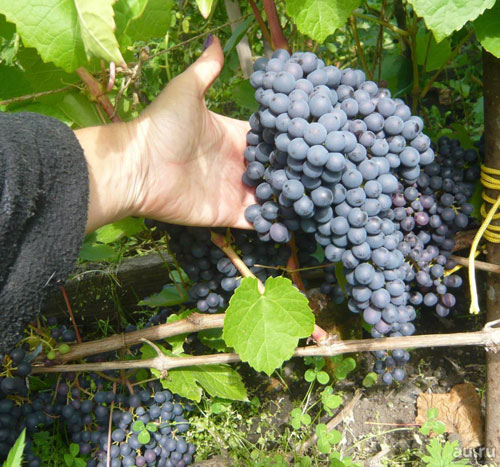 For the successful cultivation of grapes, it is imperative to carry out the following agricultural activities.
For the successful cultivation of grapes, it is imperative to carry out the following agricultural activities.
Landing
Since the grapes of “Pamyat Dombkowska” having sunlitly devoting a place for planting are necessary from the south side. The best solution is to land on the southeast or southwest side of the house. Then the plant receives more heat.
Grapes love black soil or loamy soil. If the soil is depleted, organic matter is added to it in advance: rotted manure, compost. If the soil is acidic, you need to neutralize it by applying lime.
When planting, you must pay attention to the occurrence of groundwater. If they come close to the upper soil level, it is recommended to make a drainage system or plant it on higher ground.
Before planting, seedlings should be prepared. Initially, they are sorted out, discarded rotted and weak specimens. Selected twigs at the edges are cut so that the cut is green. Then soaked in water to strengthen the root system.
When marking the pits, it is necessary to take into account the distances. Between landings, it should be at least one and a half meters, between rows - three meters. At least 40 cm to the wall of the house or shed. About one meter to the fence.
Pits should be dug to a depth of one meter. Broken brick or gravel is poured into the bottom and rammed. Next, a layer of black soil mixed with sand and compost is introduced. Prepared pits should stand for 14-30 days. Only after this they plant seedlings.
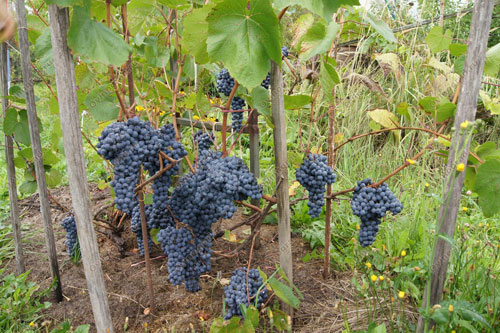 Pegs are installed in the center of the pits, a wire is tied to them. These are supports for future bushes. Seedlings are set near them and are covered with earth. When planting make organic matter; then plantings are abundantly watered with water. Gently cover with dry grass, bulbous husk.
Pegs are installed in the center of the pits, a wire is tied to them. These are supports for future bushes. Seedlings are set near them and are covered with earth. When planting make organic matter; then plantings are abundantly watered with water. Gently cover with dry grass, bulbous husk.
Pruning
For good growth and fruiting, the crop should be trimmed. The first pruning is carried out at the end of August. It is necessary that the plant is prepared for the winter and gain enough strength. Shorten the vine by 20–40 cm, cut off the upper shoots.
The second pruning is carried out in October, when the leaves completely fall. The most viable shoots are chosen, and the rest are cut off. The fruit shoot is shortened to two buds. The escape shoot is cut to 7-14 buds.
After pruning, the vine is treated with a solution of copper sulfate. In the spring after wintering, the frozen branches break off. It is better not to carry out full pruning in the spring, since juice begins to stand out in the places of incisions; the vine is draining.
Stepson and thinning
As the bush grows, empty side shoots form. They do not give clusters. But with further development, nutrients are taken from the fruiting vine. Therefore, in spring it is necessary to carry out stepsoning. Remove shoots completely.Stepsoning is carried out in the spring, in the summer and in the fall. In parallel, inspect the entire plant. Remove weak and damaged shoots.
In addition, it is necessary to thin out the green shoots on the bushes. The leaves around the clusters are completely torn off to give more sun to the ripening fruit. If the foliage does not thin out the grapes, it tends to pee.
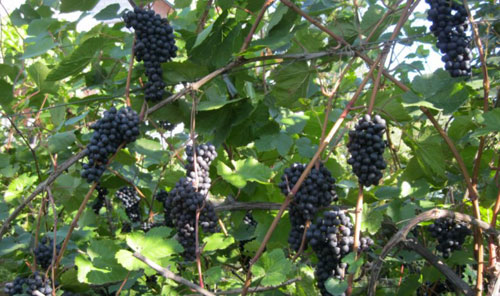
The quality of the berries also suffers. Ripening in the shade, they lose their sweetness. The taste becomes sour with some bitterness.
Watering and feeding
In the early spring and on the eve of fruiting, radical top dressing is done with organic and mineral fertilizers. Before flowering and after flowering, foliar application of nitrogen-containing fertilizers is done.
When setting fruit, it is recommended to do foliar top dressing with boron and zinc. The last top dressing is carried out in the fall, on the eve of harvesting. More often, top dressing is not recommended, since the plant begins to gain intensely leaf mass.
Watering the plant is recommended infrequently. The first watering is carried out in early spring. They resume it during the flowering period, in June. Grapes are watered no more than once a week. It is advisable to use clean water, warmed in the sun. After the start of staining, watering must be stopped.
Spraying from diseases and pests
The “Dombkovskaya Memory” has weak immunity against gray mold, mildew and oidium. Especially the plant is weakened in rainy damp weather. Therefore, for preventive purposes, spray during the season.
Tank mixtures are used for this procedure: several substances are combined in one tank. In this way, it is possible not only to get rid of fungal spores, but also to destroy harmful insects. These mixtures are also a good foliar fertilizer for culture.
Spraying is carried out after sunset so that the sun's rays do not scorch wet leaves. When preparing mixtures, attention should be paid to their compatibility. Beginner-growers will have to try to master this method.
One-time irrigation with mixtures does not help to avoid diseases. Spray mixtures according to the scheme:
- In the early spring after trimming bushes.
- Before flowering begins.
- When the ovary appears.
- Before sheltering the vine.
Preparing for the winter
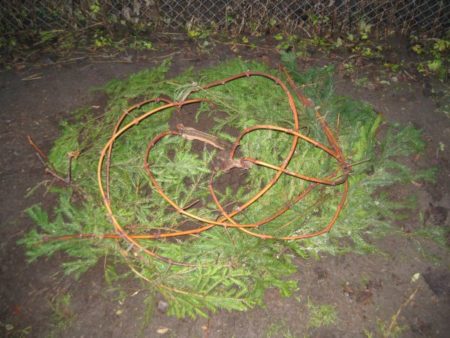 In the southern regions, the variety “Pamyat Dombkovskaya” is not harboring. The vine is removed, bent and laid on the ground. In the harsh northern winters, grapes require careful shelter.
In the southern regions, the variety “Pamyat Dombkovskaya” is not harboring. The vine is removed, bent and laid on the ground. In the harsh northern winters, grapes require careful shelter.
Spruce branches are thrown onto the ground, and a bent vine is placed on top. Above it, the spruce branches are again thrown. The ends are left open until the first frost. The top is covered with a non-woven material that protects the vine from moisture.
When it gets cold outside and the temperature reaches minus five degrees, the shelter is sprinkled on top of the ground. In some areas, this role is played by snow cover. If there is a lot of snow, it keeps heat well. With such a wintering vine feels optimal.
Reviews of amateur winegrowers
Innesa, 38 years old
The variety “In memory of Dombkovskaya” has been growing on my site for 6 years. The bushes began to bear fruit in the second year after the planting of seedlings. This winter, the plant did not harbor. I thought it would freeze. But the culture was tenacious. True, the yield this summer was low. Grapes really like. The only drawback is susceptibility to mildew. It is necessary to process several times a season.
Vladimir, 47 years old
The grapes on my site ripen in the second half of August. Bunches are large - per kilogram of weight. I like the taste of berries and the fact that the fruits are seedless. Mostly the entire crop goes to wine.
Nikita, 51 years old
The bushes are 10 years old. It is growing rapidly over the summer. The vine is powerful.Almost no processing. In this case, the plants do not get sick. In vain they say that the berries are sour. I have very sweet ripen. One drawback is small. The bunch is too dense.
Arseny, 13 years old
Very good grade. Vigorous, fruitful. The berry ripens sweet and sour, despite the short cold summer. I do a long trim. I harvest in September. Although the culture is recognized conditionally covering, I make a reliable shelter. We have severe winters, up to minus 40 degrees. I'm not going to give up grapes. This variety is the best of those that grow in our region.
The culture “In memory of Dombkovskaya” is very popular among amateur winegrowers in the north of Russia. In a cold adverse climate, grapes grow well and bear fruit. It is grown for the savor of sweet and sour-sweet berries, from which tasty preparations and pleasant wine are obtained.




 Non-covering winter-hardy grape varieties for Moscow region
Non-covering winter-hardy grape varieties for Moscow region How to keep the vine in winter
How to keep the vine in winter When can I transfer grapes to another place in the fall
When can I transfer grapes to another place in the fall How to cover and prepare grapes for the winter in the suburbs
How to cover and prepare grapes for the winter in the suburbs